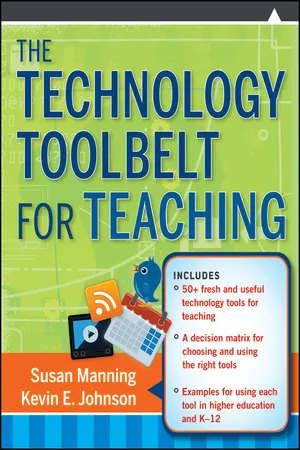
The Technology Toolbelt for Teaching
Susan Manning, Kevin E. Johnson
- English
- ePUB (disponibile sull'app)
- Disponibile su iOS e Android
The Technology Toolbelt for Teaching
Susan Manning, Kevin E. Johnson
Informazioni sul libro
Instructors are under pressure to integrate technology into their traditional or online instruction, but often they aren't sure what to do or why they should do it. The Technology Toolbelt for Teaching offers instructors a down-to-earth guide to common technologies, explains the pedagogical purposes they serve, and shows how they can be used effectively in online or face-to-face classrooms.
Designed to be easy to use, the book includes a decision-making matrix for each technology tool: a series of questions that teachers can use to decide whether these tools support their teaching goals.
This comprehensive resource contains an array of useful tools that address problems of organization such as a time management calendar, aids for scheduling meetings, and mind-mapping or graphic organizers. The authors also include a variety of online tools for communication and collaboration, and tools to present content, help establish presence, and assess learning.
Praise for The Technology Toolbelt for Teaching
"Feeling overwhelmed and even afraid of integrating technology into your course? Fear no more! Susan Manning and Kevin Johnson have provided the ultimate guide that explains not only the various technology tools that can support faculty work and enhance coursework but also provides sound advice to help faculty choose the right tool for the job. This is a must-read for all faculty regardless of their experience with technology."—Rena M. Palloff and Keith Pratt, managing partners, Crossroads Consulting Group, and authors, Building Online Learning Communities and Collaborating Online
"The Technology Toolbelt for Teaching delivers exactly what it promises: a concrete overview of a wide variety of tools, complete with examples specific to practitioners in both K–12 and higher education. Authors Susan Manning and Kevin Johnson provide practical applications rather than philosophy, and solutions rather than platitudes. This is a must for any teacher working with—or wanting to start working with—technology."—Jane Bozarth, author, Social Media for Trainers; eLearning coordinator, State of North Carolina
"Creating compelling learning experiences for students is fraught with decision points. Add one or more technology options to the equation, and the number of directions to take learners seems to grow limitlessly, and can either paralyze the instructional design process or cause us to take on too much. Enter The Technology Toolbelt for Teaching. Manning and Johnson's handy guide – and the decision-making matrix that frames each of the tools it demystifies – is an essential resource for choosing paths wisely."—Jonathan Finkelstein, author, Learning in Real Time; founder and executive producer, LearningTimes
Includes
-
50+ fresh and useful technology tools for teaching
-
A decision matrix for choosing and using the right tools
-
Examples for using each tool in higher education and K–12
Domande frequenti
Informazioni
PART ONE
INTRODUCTION
CHAPTER ONE
Why Web-Based Tools?
Defining Technology
The First Webs
Indice dei contenuti
- COVER
- CONTENTS
- TITLE PAGE
- COPYRIGHT
- SERIES
- DEDICATION
- PREFACE
- ACKNOWLEDGMENTS
- ABOUT THE AUTHORS
- PART ONE: INTRODUCTION
- PART TWO: TOOLS TO HELP YOU STAY ORGANIZED
- PART THREE: TOOLS TO COMMUNICATE AND COLLABORATE
- PART FOUR: TOOLS TO PRESENT CONTENT
- PART FIVE: TOOLS TO HELP YOU ASSESS LEARNING
- PART SIX: TOOLS TO HELP YOU TRANSFORM YOUR IDENTITY
- REFERENCES
- INDEX
- END USER LICENSE AGREEMENT